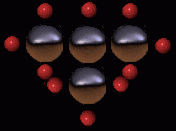 These two atoms are the ones that occur most frequently in organic compounds ... substances made by living organisms. Compounds made from just these two atoms are called hydrocarbons, and there are many different ones, as you will see. Hydrocarbon molecules can form from decaying organic garbage, or they can form after millions of years of heat and pressure on buried vegetable matter. These latter hydrocarbons occur as crude oil, and we can separate out all the different hydrocarbon molecules contained in that oil. Let's learn about some of them. The simplest hydrocarbon is one made from a single carbon atom. Carbon atoms are capable of making connections, or bonds, with four other atoms. If these connections are all filled by hydrogen atoms, we get a molecule that looks like this:
Methane is produced in nature when once-living material, such as old tree stumps, vegetable matter, or even garbage, decays or rots underground. It is also produced in underground beds of coal, since coal was once organic matter. Methane is sometimes called marsh gas.
As the molecules get larger, it becomes easier to liquefy them. Nowhere on earth is it cold enough to liquefy methane. But at 40-50 degrees below zero, propane will liquefy. And an ordinary winter day will liquefy butane. All these gases can be compressed; propane and butane are used in that form as fuels. Can even larger molecules be formed from carbon atoms linked together in a chain? Yes, they can. The molecules that result are given names based on the number of carbon atoms, using Greek number prefixes. Five carbon atoms make a molecule of pentane. Six carbons make hexane. Seven make heptane. Eight carbon atoms make a molecule of octane.  You may recognize octane as having something to do with gasoline. In fact, gasoline is a blend of several hydrocarbon molecules, including heptane and octane. These molecules are so large, they are in liquid form at ordinary temperatures. But they can turn back into gaseous form very easily, which is why their vapours are explosive. They still burn, just like methane. Carbon atoms can link up in other ways besides in a chain. They can form a ring. Or they can form a branching chain, like the following example:
When you take into account all the different ways that carbon atoms can link up, including branching and sub-branching, there are thousands of different hydrocarbon molecules. |




